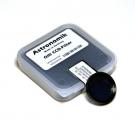Astronomik OIII CCD Filter Review
I have now moved over to collecting Astronomik filters, I did have a selection of both Baader and Astronomik filters. I have now settled on Astronomik filters for my narrowband filter set. It’s important to always stick with the same brand of filters, as they should then all be parfocal.
But don’t get me wrong I still like Baader filters as I still have a fringe killer, uv/ir and solar continuum filters from them.
The thing I like best about the Astronomik filters is how slim they are, and I never have any trouble screwing them into filter wheels, they also don’t catch on filter wheels like the height of the Baader filters.
Due to the cost of 2″ versions of filters I have gone with the 1.25″ range of filters, plus the filters wheels in the 1.25″ versions are also cheaper, this one was from StayFocused.eu
 The OIII CCD filter comes in the standard Astronomik no-frills box with a black foam backing. I was getting confused by the labels Astronomik put on their boxes, but now I think the white and black labels are the newer versions of the filters.
The OIII CCD filter comes in the standard Astronomik no-frills box with a black foam backing. I was getting confused by the labels Astronomik put on their boxes, but now I think the white and black labels are the newer versions of the filters.
As the name suggests the OIII CCD filter comes with a built-in IR-blocker up to 1150nm, so you don’t need an additional IR-blocker with this filter.
The Astronomik OIII CCD filter is a narrow band emission-line-filter for CCD photography. The filter lets the light of double ionized Oxygen of emission nebulae pass and blocks nearly the whole remainder of the spectrum where the CCD is sensitive.
The Astronomik OIII CCD increases the contrast between objects, in this case between the OIII emission line and the skyglow background. Our Astronomik OIII CCD completely suppresses the emission lines of artificial lighting (mercury (Hg) and sodium (Na)) and skyglow.
The full width at half maximum (FWHM) of 12 nm is optimal suitable for common CCD cameras and allows the use of very fast optics The optimal aperture ratio for the use of the filter is 1:3 to 1:15 with apertures of more than 6″ (150mm).
When using the Astronomik OIII CCD filter together with the H-alpha, OIII CCD and the SII CCD filters you can obtain three-color images of emission line objects (gas nebulae) from locations with very strong light pollution. To do so, you would take an image in three different wavelengths, select each one as a color-channel in Photoshop and paste them together as one single color image.
- 95% transmission at 496nm (OIII)
- 95% transmission at 501nm (OIII)
- Full width at half maximum 12nm
- Transmission from 494nm to 506nm
- Parfocal with other Astronomik filters
- Glass thickness: 1mm
- Completely resistant against high humidity, scratches and aging effects
- Diffraction limited, the filter will not reduce the optical performance of your telescope!
- Astronomik filters are delivered in a high-quality, long lasting, filter box
Astronomik OIII filters and other Astronomik filters can be purchased from StayFocused.eu

Can you give me some idea of the imaging time and frames required for Ha, OIII and SII filters as compared to RGB filters?